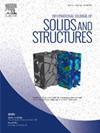大角羊角动态冲击行为调查
IF 3.4
3区 工程技术
Q1 MECHANICS
International Journal of Solids and Structures
Pub Date : 2024-11-06
DOI:10.1016/j.ijsolstr.2024.113133
引用次数: 0
摘要
大角羊的角由角蛋白生物材料组成,具有小管-拉梅拉结构,这使其在冲击载荷下具有各向异性的硬化特性。本文旨在通过建立一个考虑到羊角各向异性特征和应变率效应的数值材料模型,研究大角羊角固有的能量耗散机制。为此,本文建立了一个横向各向同性构成模型,其中包括各向异性硬化和应变速率效应,以准确预测大角羊角的机械行为。通过在准静态和动态条件下进行的单轴压缩试验对材料特性进行了分析。通过用户定义的材料子程序将所开发的构成模型应用于 LS-Dyna,并根据经验数据进行了验证。经过验证的数值模型用于研究动态加载条件下喇叭的机械响应。论文的重点是冲击能量耗散机制,包括能量吸收和转换、应力分布和位移波传播。从本文中获得的见解有望为开发具有更强能量吸收和冲击缓解性能的新型人工材料做出重大贡献。本文章由计算机程序翻译,如有差异,请以英文原文为准。
Investigation of dynamic impact behavior of bighorn sheep horn
The horn of the bighorn sheep is composed of keratin-based biological material that has a tubule-lamella structure, which gives it anisotropic hardening properties under impact loading. This paper aims to investigate the energy dissipation mechanisms inherent in bighorn sheep horns by developing a numerical material model that accounts for the horn’s anisotropic features and strain-rate effects. To this end, a transversely isotropic constitutive model, which includes both anisotropic hardening and strain-rate effects, was formulated to accurately predict the mechanical behavior of bighorn sheep horns. Material characterization was conducted through uniaxial compression tests that were conducted under quasi-static and dynamic conditions. The developed constitutive model was implemented into LS-Dyna via a user-defined material subroutine and was validated against empirical data. The validated numerical model was used to investigate the horn’s mechanical responses under dynamic loading conditions. The paper focused on impact energy dissipation mechanisms, including energy absorption and transition, stress distribution, and displacement wave propagation. The insights gained from this paper are expected to significantly contribute to the development of novel artificial materials with enhanced energy absorption and impact mitigation properties.
求助全文
通过发布文献求助,成功后即可免费获取论文全文。
去求助
来源期刊
CiteScore
6.70
自引率
8.30%
发文量
405
审稿时长
70 days
期刊介绍:
The International Journal of Solids and Structures has as its objective the publication and dissemination of original research in Mechanics of Solids and Structures as a field of Applied Science and Engineering. It fosters thus the exchange of ideas among workers in different parts of the world and also among workers who emphasize different aspects of the foundations and applications of the field.
Standing as it does at the cross-roads of Materials Science, Life Sciences, Mathematics, Physics and Engineering Design, the Mechanics of Solids and Structures is experiencing considerable growth as a result of recent technological advances. The Journal, by providing an international medium of communication, is encouraging this growth and is encompassing all aspects of the field from the more classical problems of structural analysis to mechanics of solids continually interacting with other media and including fracture, flow, wave propagation, heat transfer, thermal effects in solids, optimum design methods, model analysis, structural topology and numerical techniques. Interest extends to both inorganic and organic solids and structures.

 求助内容:
求助内容: 应助结果提醒方式:
应助结果提醒方式:


